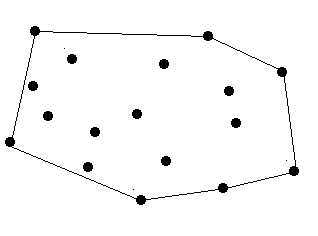标签:des style blog http io ar os sp for
Description
There are a lot of trees in an area. A peasant wants to buy a rope to surround all these trees. So at first he must know the minimal required length of the rope. However, he does not know how to calculate it. Can you help him? The diameter and length of the trees are omitted, which means a tree can be seen as a point. The thickness of the rope is also omitted which means a rope can be seen as a line.

There are no more than 100 trees.
Input
The input contains one or more data sets. At first line of each input data set is number of trees in this data set, it is followed by series of coordinates of the trees. Each coordinate is a positive integer pair, and each integer is less than 32767. Each pair is separated by blank.
Zero at line for number of trees terminates the input for your program.
Sample Input
9
12 7
24 9
30 5
41 9
80 7
50 87
22 9
45 1
50 7
0
Sample Output
#include <iostream>
#include <cstdio>
#include <cstdlib>
#include <cstring>
#include <cmath>
#include <algorithm>
#include <set>
#include <map>
#include <queue>
#include <string>
#include <vector>
#define INF 0x3fffffff
using namespace std;
struct point
{
int x, y;
};
point p[105], s[105];
bool mult(point sp, point ep, point op)
{
return(sp.x - op.x) * (ep.y - op.y) >= (ep.x - op.x) * (sp.y - op.y);
}
bool operator < (const point &p1, const point &p2)
{
return p1.y < p2.y || (p1.y == p2.y && p1.x < p2.x);
}
int graham(point *p, int n, point *s)
{
int len, top = 1;
sort(p, p + n);
if (n == 0) return 0;
s[0] = p[0];
if (n == 1) return 1;
s[1] = p[1];
if (n == 2) return 2;
s[2] = p[2];
for (int i = 2; i < n; ++i)
{
while (top && mult(p[i], s[top], s[top -1])) top--;
s[++top] = p[i];
}
len = top; s[++top] = p[n-2];
for (int i = n - 3; i >= 0; --i)
{
while (top != len && mult(p[i], s[top], s[top-1])) top--;
s[++top] = p[i];
}
return top;
}
int main()
{
//freopen ("test.txt", "r", stdin);
int n;
while (scanf ("%d", &n) != EOF && n != 0)
{
for (int i = 0; i < n; ++i)
{
scanf ("%d%d", &p[i].x, &p[i].y);
}
int len = graham(p, n, s);
double ans = 0;
long long temp;
if (len == 1)
{
printf("0.00\n");
continue;
}
if (len == 2)
{
temp = (s[0].x - s[len-1].x) * (s[0].x - s[len-1].x);
temp += (s[0].y - s[len-1].y) * (s[0].y - s[len-1].y);
ans += sqrt(temp);
printf ("%.2lf\n", ans);
continue;
}
for (int i = 0; i < len; ++i)
{
if (i == 0)
{
temp = (s[0].x - s[len-1].x) * (s[0].x - s[len-1].x);
temp += (s[0].y - s[len-1].y) * (s[0].y - s[len-1].y);
ans += sqrt(temp);
}
else
{
temp = (s[i].x - s[i-1].x) * (s[i].x - s[i-1].x);
temp += (s[i].y - s[i-1].y) * (s[i].y - s[i-1].y);
ans += sqrt(temp);
}
}
printf ("%.2lf\n", ans);
}
return 0;
}
ACM学习历程—HDU1392 Surround the Trees(计算几何)
标签:des style blog http io ar os sp for
原文地址:http://www.cnblogs.com/andyqsmart/p/4101751.html